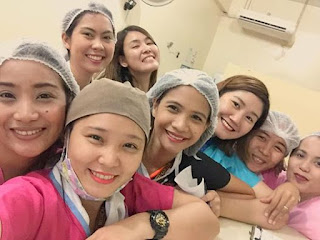Training of Trainers on the Integrated Essential Maternal and Newborn Care (EMNC) and Lactation Management Training (LMT) for Health Care Providers in Hospitals
September 20-24, 2016
The Department of Health has a lot of programs, even for the same beneficiaries there are different programs. For maternal and child health for example, we have the Essential Intrapartum and Newborn Care (EINC), the Kangaroo Mother Care (KMC), the Lactation Management Training (LMT) and even the Basic Emergency Obstetric and Newborn Care (BEmONC) training and Infant and Young Child Feeding (IYCF). To make things simpler, we now have an integration of all these training programs into one broad training of trainors, much like a sampler of everything. Hence, the Integrated Essential Maternal and Newborn Care and Lactation Management (EMNC-LM)!

As is also the norm since my three (3) years of working at the Vicente Sotto Memorial Medical Center, we are tapped by the DOH as trainers and facilitators. Rising up to the challenge of a myriad of conflicting schedules, we managed to respond.

As is also the norm since my three (3) years of working at the Vicente Sotto Memorial Medical Center, we are tapped by the DOH as trainers and facilitators. Rising up to the challenge of a myriad of conflicting schedules, we managed to respond.
The first batch took place on June 13-18, 2016 at Bayview Park Hotel in Manila.
The second batch was conducted at the Cebu Business Hotel in Cebu City. For the Cebu batch, participants include Far North Luzon General Hospital, Luis Hora Memorial Regional Hospital, Novaliches District Hospital, Batangas Medical Center, Eastern Visayas Regional Medical Center, Schistosoma Research and General Hospital, Amai Pakpak Medical Center, Mayor Hilario Ramiro Sr Regional Teaching and Training Hospital, CARAGA Regional Hospital, and Vicente Sotto Memorial Medical Center.
Aside from introducing the laws to protect breastfeeding and the support system needed to ensure continuous successful feeding, it has to start long before labor and delivery, possibly during antenatal care. This sentiment was echoed during the last session on supportive supervision.
The programs on promoting breastfeeding should consider the hospital policies, the capabilities of the healthcare works, the health education and promotion classes, as well as support groups in the community.
 This training seminar included also facilitation and communication skills, in addition to promotion of breastfeeding during pregnancy, through EINC especially during non-separation of mother and child during the entire hospital stay, practices that protect breastfeeding, as well as introducing Kangaroo Mother Care for preterm babies and low birth weight babies.
This training seminar included also facilitation and communication skills, in addition to promotion of breastfeeding during pregnancy, through EINC especially during non-separation of mother and child during the entire hospital stay, practices that protect breastfeeding, as well as introducing Kangaroo Mother Care for preterm babies and low birth weight babies.The participants visited the Vicente Sotto Memorial Medical Center to interact with the mothers and to experience for themselves how a busy overcrowded government hospital implements government programs despite the challenges of inadequate space maximizing 300-400% bed capacity, undermanned service areas and limited resources.
It warms my heart to hear that the participants appreciated the presence of the Intensive Maternal Unit, which aims to separate pregnant patients with special concerns such as hypertension, preterm labor, infections during pregnancy and antenatal bleeding.
As a case in point, when we had to move temporarily to the Trauma Center for the duration of the construction of the Perinatal Care, we only had a labor room-delivery room complex with the neonatal intensive care unit attached to it. We had no extra space. We really had to request for a specific space for the Intensive Maternal Unit (IMU). Patients with high risk pregnancies complicated by hypertension, antenatal hemorrhage, preterm labor, gestational diabetes mellitus, infections in pregnancy, and other co-morbidities are admitted at the Intensive Maternal Unit, which is under the supervision of maternal health specialists like the perinatologist and the infectious disease specialist. With cohorting as a strategy, we noted that the conditions of these patients could not be managed while they were staying at the jampacked labor room. Patients in labor have to take turns lying down on the bed because several of them have no choice but to share on bed. Patients in labor understandably feel discomfort and intense pain due to childbirth. These uncomfortable circumstances would not help control the blood pressure of a hypertensive, for example. Hopefully, all government hospitals would have an intensive maternal unit, supervised by a maternal-fetal medicine/perinatology specialist so as to reduce maternal and child morbidity and mortality.
 In the end, what is important is the identification of champions for the program - whether in the community, in the hospital or in the head office of the Department of Health. These are people who truly believe that by implementing these programs, our population of mother and children will be better fed, better nourished, better cared for and healthier. Congratulations to the team of Dr Anthony Calibo and Ms Aya Escober!
In the end, what is important is the identification of champions for the program - whether in the community, in the hospital or in the head office of the Department of Health. These are people who truly believe that by implementing these programs, our population of mother and children will be better fed, better nourished, better cared for and healthier. Congratulations to the team of Dr Anthony Calibo and Ms Aya Escober!
Here is the video TV commercial by the Department of Health for the promotion of breastfeeding, All for Health towards Health for All!










